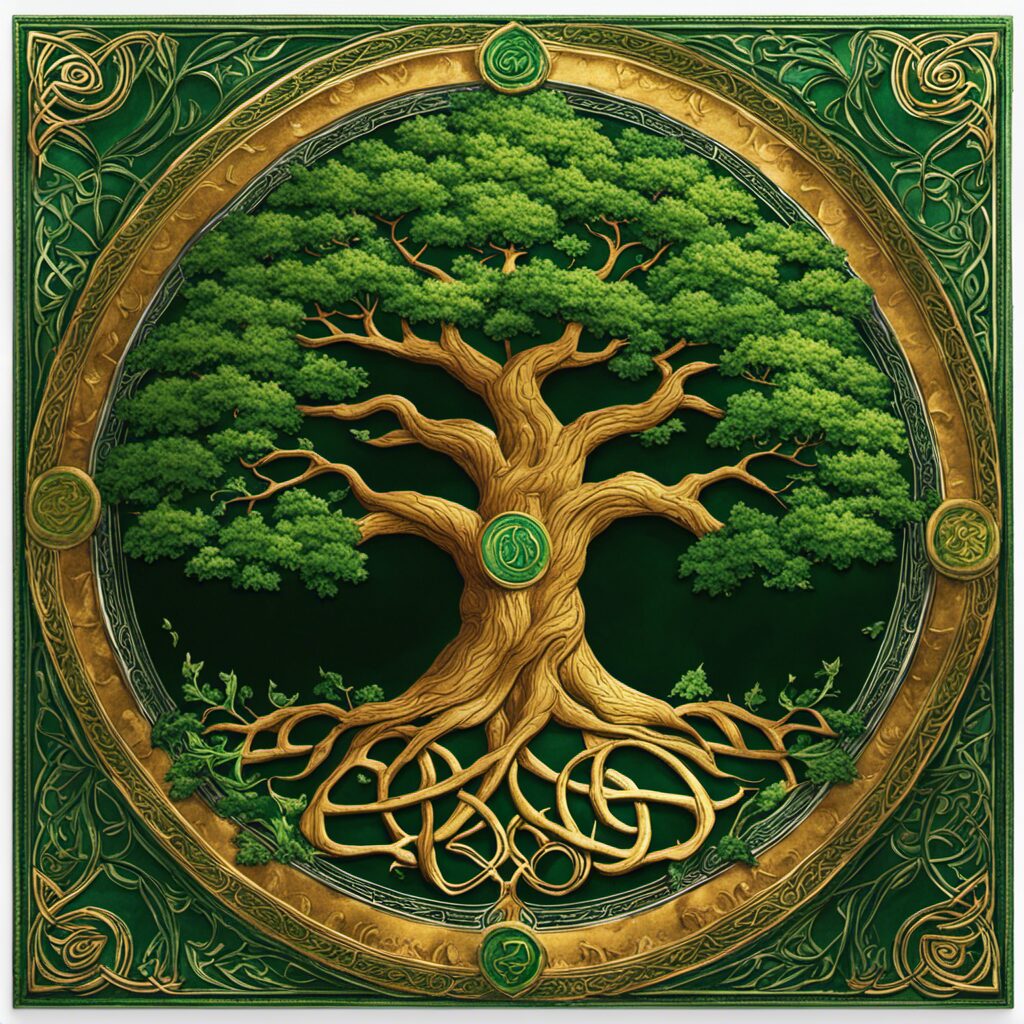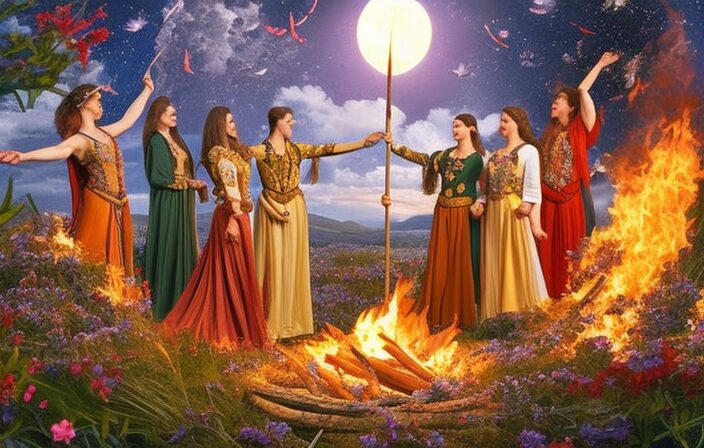The Lunisolar Celtic Calendar holds a significant place in Celtic culture. It has an intricate connection between the lunar phases and Celtic festivals. This ancient calendar system has a rich history, structure, and significance. By examining the relationship between the moon and the cultural practices of the Celts, we can gain insights into their beliefs and traditions.
This article aims to delve into the history, structure, and significance of the Lunisolar Celtic Calendar. It will explore how the lunar phases and Celtic festivals are intricately connected in this calendar system. We will also examine the cultural practices of the Celts and how they are influenced by the lunar cycles.
In addition to exploring the ancient calendar system, this article will also touch upon modern interpretations and adaptations that have emerged around the Lunisolar Celtic Calendar. We will look at how this unique calendar system continues to be celebrated and understood in contemporary Celtic culture.
Overall, this article will provide a comprehensive overview of the Lunisolar Celtic Calendar, its historical roots, its cultural significance, and its relevance in modern times.
Key Takeaways
- The Lunisolar Celtic Calendar originated in ancient Celtic cultures during the Iron Age and was based on their beliefs and practices.
- The calendar consisted of both solar and lunar cycles, with intercalary months added to synchronize the lunar and solar years.
- The Celtic festivals were intricately linked to specific phases of the moon, and the calendar followed a lunisolar system.
- The moon played a crucial role in determining festival timing, symbolizing cycles of birth, growth, death, and rebirth, and influencing agriculture and tides.
History and Origin
The history and origin of the lunisolar Celtic calendar can be traced back to ancient Celtic cultures and their observance of lunar phases. The origins of the calendar are rooted in the beliefs and practices of the Celts, a group of Indo-European peoples who inhabited parts of Western Europe during the Iron Age. The Celts placed great importance on natural cycles, particularly those related to agriculture and celestial bodies. As such, they developed a calendar that was closely tied to both solar and lunar movements.
The Celtic calendar was lunisolar in nature, meaning it followed both lunar phases and solar events. It consisted of a series of months based on the moon’s cycle, with each month corresponding to a specific phase or aspect of the moon. Additionally, intercalary months were added periodically to synchronize the lunar year with the solar year.
The cultural significance of the Celtic calendar cannot be overstated. It served as more than just a tool for tracking time; it was deeply intertwined with religious beliefs, agricultural practices, and social customs. The observance and celebration of specific lunar phases were considered auspicious times for various activities such as planting crops, conducting rituals, or holding festivals.
Celtic Calendar Structure
Constructed around a system of interrelated cycles, the Celtic calendar structure incorporates both solar and lunar elements. The calendar was closely tied to Celtic agricultural practices and seasonal celebrations. It consisted of two main cycles: the solar cycle, which marked the passage of time based on the position of the sun in relation to Earth, and the lunar cycle, which followed the phases of the moon.
The solar cycle divided the year into four major festivals known as ‘fire festivals,’ each marking an important point in the agricultural calendar. These festivals were celebrated with bonfires and rituals that symbolized purification, fertility, and protection against evil spirits. The four fire festivals were Imbolc (February 1st), Beltane (May 1st), Lughnasadh (August 1st), and Samhain (November 1st).
In addition to these major festivals, smaller ceremonies were held throughout the year to honor specific agricultural activities such as planting or harvesting. These ceremonies reflected a deep connection between Celtic people and their land, emphasizing their reliance on agriculture for survival.
Overall, the Celtic calendar structure integrated both solar and lunar elements to guide agricultural practices and mark significant points in time for seasonal celebrations. Its cyclical nature ensured a continuous connection between humans, nature, and cosmic rhythms.
Lunar Phases and Celtic Festivals
Incorporating both solar and lunar elements, the Celtic festivals were intricately linked to specific phases of the moon. These lunar celebrations held great significance in ancient Celtic traditions. The Celts followed a lunisolar calendar, which means that their calendar was based on both the cycles of the sun and the moon. This allowed them to track time in relation to both celestial bodies.
The lunar phases played a crucial role in determining when certain festivals were celebrated. Each month in the Celtic calendar began with a new moon, known as Samhain. This marked the beginning of a new lunar cycle and was associated with rebirth and renewal. The full moon, known as Beltane, was also an important festival that signified fertility and growth.
Other festivals such as Imbolc and Lughnasadh were tied to specific points between these two lunar events. Imbolc occurred around the first quarter moon phase, symbolizing the onset of spring and new life. Lughnasadh, on the other hand, took place during the last quarter moon phase, representing harvest and abundance.
These ancient traditions reflect how deeply connected the Celts were to nature’s cycles, particularly those influenced by the movements of celestial bodies like the sun and moon.
Significance of Moon in Celtic Culture
Moon played an important role in determining the timing of various festivals in ancient Celtic culture. The moon held significant symbolism and was associated with lunar deities in Celtic mythology. The Celts had a deep reverence for the moon, considering it as a source of guidance and wisdom.
In Celtic culture, the moon was seen as a symbol of cycles, representing birth, growth, death, and rebirth. It was believed to have influence over the natural world, including tides and agriculture. The phases of the moon were closely observed by the Celts to determine auspicious times for planting crops or conducting rituals.
Lunar deities played a prominent role in Celtic mythology. One such deity is Arianrhod, known as the Welsh Moon Goddess. She presided over fertility, childbirth, and fate. Another notable lunar deity is Manannán mac Lir, an Irish sea god who controlled the tides and navigational skills.
The moon’s influence extended beyond agricultural practices and mythology; it also shaped the Celtic calendar. Festivals were often celebrated during specific lunar phases to honor deities or mark important events such as harvests or solstices.
Overall, the moon held great significance in ancient Celtic culture through its symbolism and association with lunar deities. Its cycles guided their agricultural practices and influenced their religious beliefs and rituals.
Modern Interpretations and Adaptations
Modern interpretations and adaptations of ancient Celtic culture have led to the revival and appreciation of traditional festivals and rituals associated with lunar cycles. These contemporary revivals are significant in terms of their cultural implications and contemporary relevance.
The revival of traditional Celtic festivals and rituals, such as Beltane and Samhain, demonstrates the enduring cultural significance of lunar cycles in Celtic culture. These celebrations often involve the recognition of specific moon phases, such as the full moon or new moon, which hold symbolic importance within the Celtic lunar calendar. The modern interpretation and adaptation of these rituals allow individuals to connect with their ancestral heritage while also providing a sense of belonging and community.
Furthermore, these revived traditions have found contemporary relevance in various aspects of modern society. For example, many people now incorporate elements from Celtic lunar rituals into their spiritual practices or personal wellness routines. Additionally, some communities organize public events centered around these festivals to foster a sense of cultural identity and celebrate diversity.
Conclusion
In conclusion, the Celtic lunisolar calendar holds a rich history and cultural significance. Its structure is based on the lunar phases and aligns with the Celtic festivals throughout the year.
The moon plays a vital role in Celtic culture, symbolizing femininity, intuition, and magic. Although the original calendar has evolved over time, modern interpretations and adaptations still honor its traditions.
By understanding the connections between celestial bodies and human experience, we gain insight into our ancestors’ beliefs and deepen our appreciation for their unique worldview.




